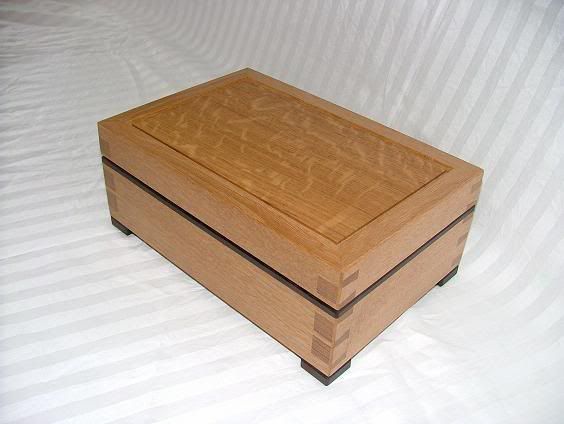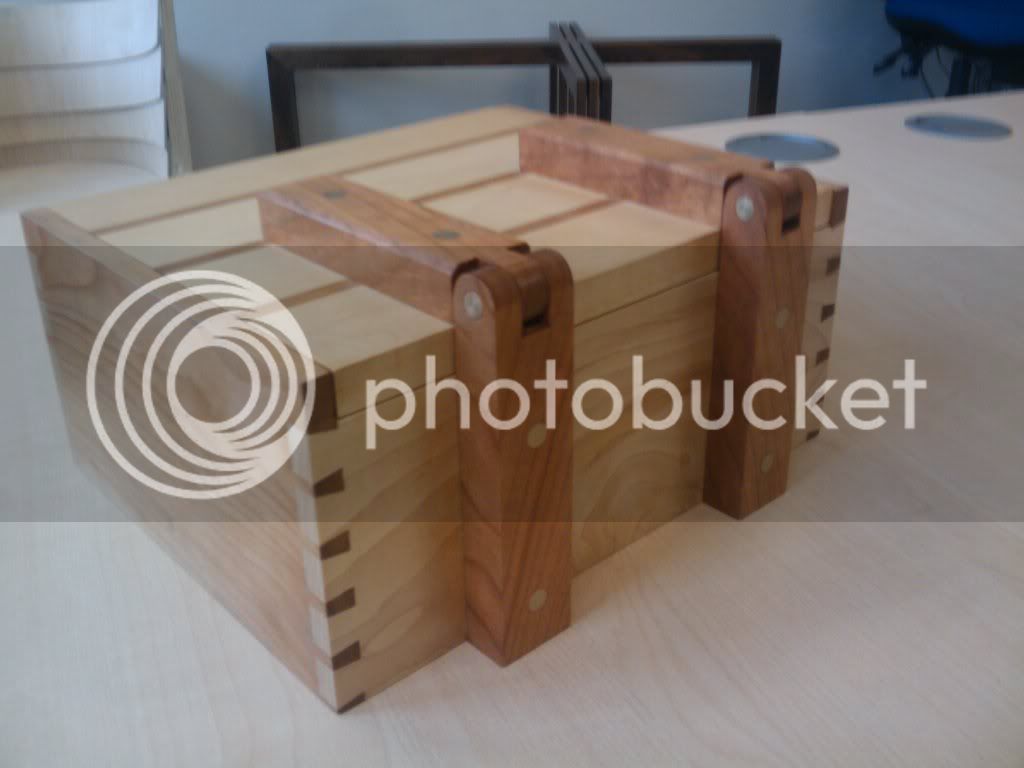joiner_sim
Established Member
The following work-in-progress can be also followed on my website at http://www.JoinerSim.vze.com where it will be updated first and then on here shortly after.
Firstly, may I apoligise for the poor photo quality of some of the images that are going to appear. This is due to the camera phone being easier to "snap" the picture when needed. However, I will make an effort to take pictures with a decent digital camera when I have time to fetch it and when the item is finished, to show it in detail.
The first thing I had to do was find out what hardware I was going to use, as this would determine the design of the box and dimensions of the timber. I decided upon ordering pre-machined 120x17mm North American White Oak. This is a little bit of forward planning for the future, as the actual sides of this box I am making are only going to be 57mm high. But the 120mm width allows me to make a variety of boxes in the future, as there will be some timber spare. The picture below shows my plan that I've drew up. The overall dimension is to be 234x84mm.

The lid will not be glued in and cut out later. I will make the box without the lid and cut a piece of timber to suit the box and hinge. However, the base has caused me to have to think quite a bit! I have decided it will be rebated in and the dovetailed joint will stop just at the base and will be mitred so the rebates are hidden. To show what I mean and to also help myself understand what I will be trying to achieve I have drawn the detail in the next picture.

With the design process dealt with, now's the time to get down to business and start making it happen! So, today I have been down to my home workshop space and unpackaged the timber that arrived earlier in the week. Following advice from a video on Get Woodworking, I have tried to keep the box sides all together so that the grain will sort of match up. This is fine for one side and one back, also for one side and one front, however it will not match all the way around as the 120mm timber is going to be ripped down the middle and each piece will give me my 57mm high sides. In the next photo you will see how far I have got now, which is to the point of marking the length of the front, back, left & right sides, ready for cutting.

And I'm sorry to say, but have to.... thats as far as I've got now. The reason being that I'll cut the timber at work this week on the table saw rather than do it by hand at home, also I need to rebate the pieces for that base and other than going out and buying a new router cutter for it, it will be much easier, cleaner and safer to do the rebates on the spindle moulder also at work. I will try and remember to photograph the ripping, crosscutting and rebating in progress if I have time, but will be limited as this will have to be done on my break times! Once the timber has been cut and rebated, I guess the dovetails will be next on the to-do list. So please keep watching and your comments/ advice are as always on a work-in-progress, very welcome.
Firstly, may I apoligise for the poor photo quality of some of the images that are going to appear. This is due to the camera phone being easier to "snap" the picture when needed. However, I will make an effort to take pictures with a decent digital camera when I have time to fetch it and when the item is finished, to show it in detail.
The first thing I had to do was find out what hardware I was going to use, as this would determine the design of the box and dimensions of the timber. I decided upon ordering pre-machined 120x17mm North American White Oak. This is a little bit of forward planning for the future, as the actual sides of this box I am making are only going to be 57mm high. But the 120mm width allows me to make a variety of boxes in the future, as there will be some timber spare. The picture below shows my plan that I've drew up. The overall dimension is to be 234x84mm.

The lid will not be glued in and cut out later. I will make the box without the lid and cut a piece of timber to suit the box and hinge. However, the base has caused me to have to think quite a bit! I have decided it will be rebated in and the dovetailed joint will stop just at the base and will be mitred so the rebates are hidden. To show what I mean and to also help myself understand what I will be trying to achieve I have drawn the detail in the next picture.

With the design process dealt with, now's the time to get down to business and start making it happen! So, today I have been down to my home workshop space and unpackaged the timber that arrived earlier in the week. Following advice from a video on Get Woodworking, I have tried to keep the box sides all together so that the grain will sort of match up. This is fine for one side and one back, also for one side and one front, however it will not match all the way around as the 120mm timber is going to be ripped down the middle and each piece will give me my 57mm high sides. In the next photo you will see how far I have got now, which is to the point of marking the length of the front, back, left & right sides, ready for cutting.

And I'm sorry to say, but have to.... thats as far as I've got now. The reason being that I'll cut the timber at work this week on the table saw rather than do it by hand at home, also I need to rebate the pieces for that base and other than going out and buying a new router cutter for it, it will be much easier, cleaner and safer to do the rebates on the spindle moulder also at work. I will try and remember to photograph the ripping, crosscutting and rebating in progress if I have time, but will be limited as this will have to be done on my break times! Once the timber has been cut and rebated, I guess the dovetails will be next on the to-do list. So please keep watching and your comments/ advice are as always on a work-in-progress, very welcome.








































